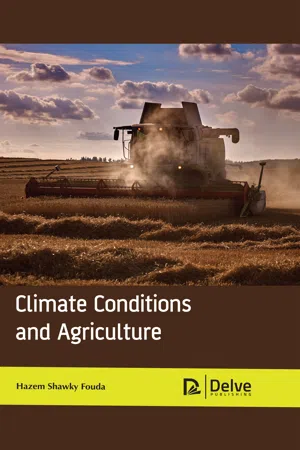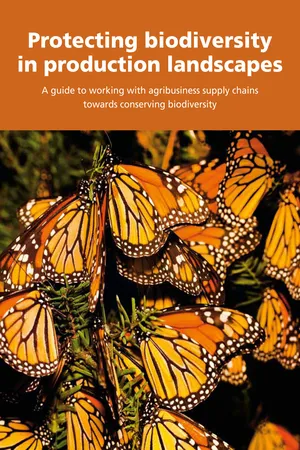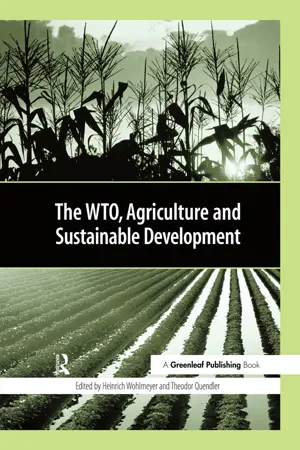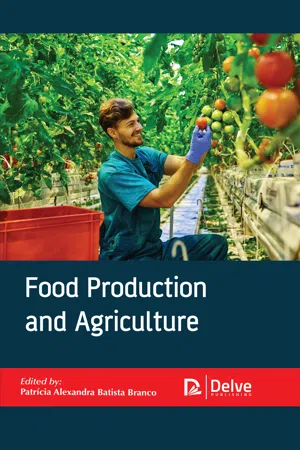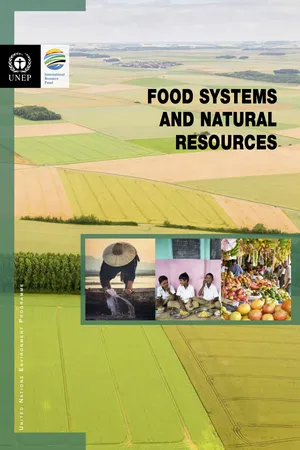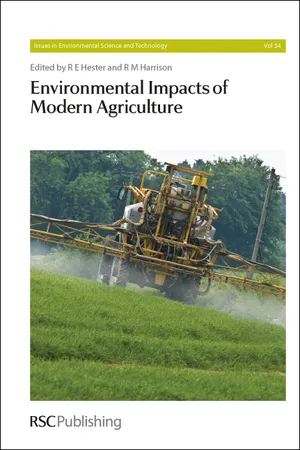Geography
Environmental Impact of Agriculture
The environmental impact of agriculture refers to the effects of farming practices on the natural surroundings. These impacts can include soil erosion, water pollution from agricultural runoff, deforestation for farmland, and greenhouse gas emissions from livestock. Sustainable agricultural practices aim to minimize these negative impacts and promote environmental conservation.
Written by Perlego with AI-assistance
Related key terms
1 of 5
8 Key excerpts on "Environmental Impact of Agriculture"
- eBook - ePub
Global Environmental Change
A Natural and Cultural Environmental History
- Antoinette Mannion(Author)
- 2014(Publication Date)
- Routledge(Publisher)
CHAPTER 8 The Environmental Impact of Agriculture in the developing world 8.1 Introduction Population growth, foreign aid and the desire to earn foreign currency have, in the past 50 years, stimulated the expansion of agriculture in developing nations and have thus prompted environmental change. Although there are many success stories in terms of increased food supply (China can now feed its population of 1.115 billion), the expansion and intensification of agriculture have also brought about environmental degradation. As in the case of the developed world (Chapter 7), the impact of agriculture is manifest in the loss of natural habitats and associated loss of biodiversity. This is affecting all types of natural ecosystems but the loss of tropical forests is of greatest concern because of the impact it is likely to have on global climate and because of the loss of species which might generate useful substances, e.g. pharmaceuticals and agricultural chemicals, in the future. The removal of the natural vegetation cover gives rise to soil erosion and degradation; this may reach such proportions that agricultural systems become unproductive. In situ soil degradation, which causes loss of production, can also occur. However, there are examples of successful soil conservation which demonstrate that land degradation can be reversible and productivity restored. This is also true of desertification, which is more extensive in the developing world than in the developed world. Nevertheless, it is a particularly serious problem in Africa and Asia. Agricultural practices have also had a major impact on water quality in the developing world. For example, cultural eutrophication is becoming increasingly significant as developing countries turn to artificial fertilisers to boost agricultural production - eBook - PDF
- Hazem Shawky Fouda(Author)
- 2019(Publication Date)
- Delve Publishing(Publisher)
Environmental Management in Relation to Agricultural Practices 9 CONTENTS 9.1. Introduction .................................................................................... 170 9.2. Nature Of Environmental Degradation ............................................ 171 9.3. Climatic Conditions On Mountainous Regions And Their Effects On Agricultural Production ............................................... 172 9.4. The Relationship Between Social Structure And Physical Environment ............................................ 177 9.5. The Need For A Healthy Environment In Agricultural Practices ........ 184 9.6. Public Awareness Of Environmental Problem ................................. 187 9.7. Key Industries That Pollute The Environment ................................... 189 9.8. Environmental Impacts Assessment In Agricultural Sector ............... 191 9.9. Methods Used In Environmental Impact Assessments ..................... 196 9.10. Environmental Protection .............................................................. 197 9.11. The Role Of International Communities In Management And Protection Of The Environment ............................................. 198 9.12. The Role Of Women In Conservation And Protection Of Environment ................................................................................. 201 Climate Conditions and Agriculture 170 9.1. INTRODUCTION Environment is defined as the totality of all those physical, chemical, biological and socio-economic factors that impinge on an individual, a population and a community. These factors include: • Human ecology • Public and occupational health • Safety • Pollution of the air, water, and land • Waste reduction • Management of unique habitats • Aesthetic and cultural preservation The environment is the integral natural-resources system, and it includes man and man’s manipulation of this system. - eBook - ePub
Hungry for Profit
The Agribusiness Threat to Farmers, Food, and the Environment
- Fred Magdoff, John Bellamy Foster, Frederick H. Buttel, Fred Magdoff, John Bellamy Foster, Frederick H. Buttel(Authors)
- 2000(Publication Date)
- Monthly Review Press(Publisher)
Chapter FourECOLOGICAL IMPACTS OF INDUSTRIAL AGRICULTURE AND THE POSSIBILITIES FOR TRULY SUSTAINABLE FARMING
MIGUEL A. ALTIERIUntil about four decades ago, crop yields in agricultural systems depended mainly on internal resources, recycling of organic matter, built-in biological control mechanisms, and natural rainfall patterns. Agricultural yields were modest but stable. Production was safeguarded by growing more than one crop or variety in a field as insurance against pest outbreaks or severe weather. Inputs of nitrogen were gained by rotating major field crops with legumes. Growing many different types of crops over the years in the same field also suppressed insects, weeds, and diseases by effectively breaking the life cycles of these pests. A typical corn-belt farmer grew corn rotated with several crops including soybeans as well as the clovers, alfalfa, and small grains needed to maintain livestock. Most of the labor was done by the family with occasional hired help, and no specialized equipment or services were purchased from off-farm sources. In these types of farming systems the link between agriculture and ecology was quite strong and signs of environmental degradation were seldom evident.1The significance of biological diversity in maintaining such systems cannot be overemphasized. Diversity of crops above ground as well as diversity of soil life below ground provided protection against the vagaries of weather, market swings, as well as outbreaks of diseases or insect pests.2 But as agricultural modernization progressed, the ecology-farming linkage was often broken as ecological principles were ignored or overridden. Numerous agricultural scientists agree that modern agriculture confronts an environmental crisis. A growing number of people have become concerned about the long-term sustainability of existing food production systems. Evidence has accumulated showing that, while the present capital- and technology-intensive farming systems have been extremely productive and able to furnish low-cost food, they also bring a variety of economic, environmental, and social problems.3 - No longer available |Learn more
Protecting Biodiversity in Production Landscapes
A Guide to Working with Agribusiness Supply Chains towards Conserving Biodiversity
- (Author)
- 2012(Publication Date)
- United Nations Development Programme (UNDP)(Publisher)
The major impacts on biodiversity and ecosystem services resulting from agricultural production include: Trees in central Sudan have been cut for firewood ©FAO/F. McDougall Protecting biodiversity through Improved Agricultural Practices 27 1. Habitat conversion: Conversion of forests, grasslands and wetlands to farmland results in loss or fragmentation of habits. This in turn contrib- utes to degradation of ecosystem services such as flood and erosion control. Genetic stocks can also be diminished or lost during land clearance work. Large-scale forest clearance also results in the release of substantial amounts of carbon dioxide and loss of carbon sinks. Activities undertaken as a result of foreign acquisition of large tracts of land by foreign companies, and in some cases, by government initia- tives, are major causes of conversion of land to agricultural use today. 2. Water usage: Approximately 70% of all water usage has been attributed to agriculture (Baroni et al. 2007). Many areas are affected by lowering water tables and water shortages as a result of large- scale irrigation. (The vast reduction in the size of the Aral Sea is a prime example in this regard. Ineffi- cient irrigation systems not only waste significant amounts of water, but can also contribute to increas- ing salinity levels, resulting in reduced productivity or desertification). 3. Pollution: Excess or inappropriate application of crop inputs such as fertilizers, herbicides and pesticides can result in damage to surrounding areas via run-off or spray drifting into surrounding areas. Chemicals carried by run-off from farms may cause the widest impacts by affecting water supplies for those downstream, potentially causing biodiversity losses and the need to purify water for consumption or business use. Even fishing and tourism activities can be affected by damage or destruction of coral reefs and other marine, lake and river ecosystems. - eBook - ePub
- Heinrich Wohlmeyer, Theodor Quendler(Authors)
- 2017(Publication Date)
- Taylor & Francis(Publisher)
Some of the above-mentioned arguments have already shown implicitly that agriculture produces ‘by-products’ during the production process for which farms are not paid. In economic theory benefits that occur as by-products during the economic production process and that are consumed by the public without rewarding the producer are called ‘positive externalities’. Such effects are not to be found exclusively in agriculture and are therefore not to be seen as an argument for giving this sector a special status. Still, it seems unambiguous and unanimously agreed that in the case of agriculture the extent of the effects and the number of beneficiaries seem to be somewhat remarkable.The relevant questions concerning agricultural production and its contributions to the protection and preservation of the environmental media—soil, water, air and biodiversity—will be dealt with in Chapter 13 . In what follows we deal with two other major benefits: the preservation of the cultural landscape, and risk management.Generally speaking, cultural landscapes are defined as landscapes shaped and maintained by human activity. Agricultural landscapes, which have been shaped by agricultural activity for centuries, constitute a major category of such landscapes. As well as the economic value of food production, the following values are typically derived from such landscapes:- Leisure value (contribution of the landscape to human health and human well-being)
- Aesthetic, cultural and historical values
- Biological and ecological values
These values are sustained by an agricultural production method adapted to the specific landscape and its environmental conditions. They are to be seen as by-products that cannot be decoupled from agricultural activity.Turning to risk management, it is important to recognise that prolonged agricultural production is synonymous with a minimisation of risk. It minimises the risk of food shortage arising from a cut in food imports—something that may become increasingly important in the context of a higher potential incidence of crop failures resulting from climatic change and severe weather events (e.g. floods and hurricanes). It also minimises the risk of losing know-how about agricultural production methods and specifically adapted cultivation techniques over time. Such knowledge, which in many cases is based on working experience, could be regained only in the long run. Its loss threatens food shortages if production, having once stopped, must be abruptly restarted. The risk of food shortage as a result of political unrest or logistical breakdowns tends, today, to be underestimated. The tendency is to centralise the logistics of food-supply operations and to decrease national buffer stocks, which increases national vulnerabilities to any supply problems. - eBook - PDF
- Patrícia Alexandra Batista Branco(Author)
- 2019(Publication Date)
- Delve Publishing(Publisher)
THE EFFECT OF ENVIRONMENTAL FACTORS AND CLIMATE CHANGE ON AGRICULTURAL FOOD PRODUCTION CONTENTS 8.1 Introduction ..................................................................................... 174 8.2 Environmental Factors ..................................................................... 174 8.3 Some Climatic Elements And Their Relationship to Farming Systems ........................................................................... 189 Chapter 8 Food Production and Agriculture 174 8.1 INTRODUCTION The logical subtleties in the environmental change domain are plentiful. In the dangerous atmospheric deviation (otherwise known as an environmental change) domain, there is a range of convictions among people in general. The individuals who tend to see these issues in dark or white terms, and who would prefer not to be bothered with understanding the points of interest of the global temperature rise have a tendency to incline toward either extreme. It is clear and evident that global warming is man-made and proper policy formations, as well as regulation, is required to deal with it as the consequences can be life-threatening. 8.2 ENVIRONMENTAL FACTORS Physical elements in any given place determine what a farmer can produce, how and when to produce. Certain ecologic parameters are possibly the most important factor for a farmer. These include: • Rainfall characteristics • Temperatures characteristics • Soils characteristics Of these parameters rainfall pattern, its distribution, reliability, intensity and effectiveness are the most significant factors. It is the main cause of uncertainties that surround the farmer’s decision-making environment. On the other hand, soils, the surface configuration of the land and temperatures are equally useful determinants of the farming activities at the regional level. However, some of these technical elements are difficult to quantify due to the paucity of accurate data. - eBook - PDF
- (Author)
- 2016(Publication Date)
- United Nations Environment Programme(Publisher)
Each subsection closes with a brief summary of biophysical options for the more efficient and sustainable use of the particular resource. The current and projected environmental impacts of food production and consumption are described in Section 5.9. The chapter closes with an overview of the resource use and environmental impacts of different food products and diets (Section 5.10). 5.2 Land, landscape and soils 5.2.1 Land use and food systems Humankind has increasingly transformed land and ecosystems in order to increase food production or other outputs, leading to major changes in biodiversity, biogeochemistry and climate (Ellis et al., 2013). Currently, of the 149 million km 2 of total global land area, 15 million km 2 (1500 million hectares) are predominantly being used for crop production (including permanent crops and fallow land) and around 34 million km 2 for rangelands (including grassland and other areas growing primarily native vegetation) (FAO, 2011e). Globally, croplands produce the largest share of food, although the contribution from other sources (rangelands, fisheries, hunting and gathering) should not be underestimated. In some traditional food systems, these sources even provide a major part of the diet. Within food systems, land is predominantly used for primary production, although locally large areas are allocated to other activities such as food processing, retail and restaurants. Due to high local concentrations of the population, for example in urban centers, food demand exceeds local production potential in many areas, leading to large trade flows within and between countries (Chapter 4). Soils are a major component of the land resource, since soil quality is an important determinant of the suitability of land for agriculture, in combination with other land characteristics (such as slope) and climate. Landscapes refer to interacting ecosystems related to the spatial configuration of heterogeneous types of land use. - eBook - PDF
- R M Harrison, R E Hester(Authors)
- 2012(Publication Date)
- Royal Society of Chemistry(Publisher)
Intensive agriculture with heavy machinery and large livestock units has also caused soil compaction which is related to factors such as soil texture, packing density, moisture content and plasticity. Compacted soils are also more prone to erosion due to greater ease of runoff associated with the lack of surface roughness and a reduction in tendency for water to seep through the soil profile. Soil biodiversity acts as the engine that makes soil alive and functional in the many processes that it governs. Soil biodiversity is influenced by a wide range of factors including the physico-chemical environment ( e.g. pH, temperature, water); the supply and availability of soil plant-derived inputs; managed inputs and indigenous organic matter; and the soil habitat. The sources of soil contaminants can be from diffuse or point source pollution and can be broadly classified as nutrients, heavy metals or organic pollutants. These soil contaminants can influence soil biodiversity. Soil sealing and salinisation only affect a small component of agricultural land. 35 Issues in Environmental Science and Technology, 34 Environmental Impacts of Modern Agriculture Edited by R.E. Hester and R.M. Harrison r The Royal Society of Chemistry 2012 Published by the Royal Society of Chemistry, www.rsc.org * Corresponding author 1 Introduction to Soil Quality Globally arable and grassland cover areas nearly 16 and 30 million km 2 , equivalent to the size of South America and Africa, respectively. Nearly 40% of the surface area of the earth is devoted to agriculture which is more than urban and suburban areas. 1 The agricultural activity results in 30% of global greenhouse gas emissions and 70% of global water withdrawal. 1 Consequently, the impact of agriculture is significant and this pressure is going to increase with the growth in global population and demand for food production.
Index pages curate the most relevant extracts from our library of academic textbooks. They’ve been created using an in-house natural language model (NLM), each adding context and meaning to key research topics.

